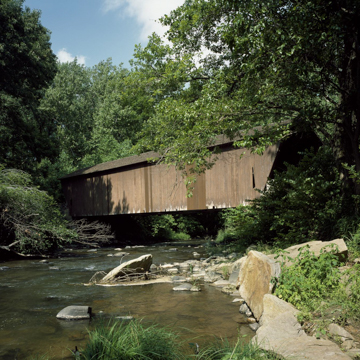Jericho is one of only six extant covered bridges in Maryland and a good representation of the innovative Burr arch through truss, named for original designer Theodore Burr and first developed in 1804. The covered bridge came about during the era of timber-frame bridge construction in areas of extreme weather as a means of protecting the wood components from water damage caused by snow and rain. It has become a quintessential American structural form that enjoys broad appeal.
The Burr truss combines a parabolic arch to bear the load with a multiple king-post truss to keep the bridge rigid. The long arches to either side are sandwiched between king-post structures to create an extremely stable bridge. Burr was among the earliest and most prominent bridge builders in the country, and his truss was used frequently by local bridge builders such as Forsyth. The bridge was a boon to the local industries that had advocated for its construction, aiding in a more direct transport of goods. Despite renovations in 1937 and 1982, the bridge remains a significant example of its type.











